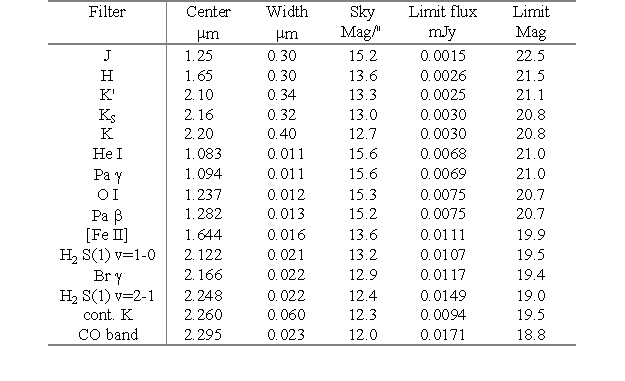
Technical Characteristics and Astronomical Performance
Array Type:
Rockwell 256x256 pixel NICMOS3 array,
(HgCdTe detector + Si
MOSFET non-destructive readout)
Wavelenth range:
1.0 µm - 2.5 µm
Quantum efficiency:
~0.4 at J (1.2 µm), ~0.5 at H (1.65 µm), ~0.6 at K (2.2 µm)
Bad pixels:
~ 1 %
Dark current:
< 0.5 e-/sec
Read noise:
~ 40 e- RMS in standard reset-read-read-mode
~ 14 e- RMS in multiple-end-point mode
Well capacity:
~3x10E5 electrons
Telescopes:
The camera can be mounted on the Calar Alto 3.5 m, 2.2 m or 1.23 m
telescopes.
Pixel scales:
- 3.5m,
- f/10,
- Wide-field: 0.81"/pix;,207" field
- High-resolution: 0.32"/pix, 82" field
- f/45,
- Wide-field: 0.18"/pix, 46" field
- High-resolution: 0.07"/pix, 18" field
- 2.2m,
- f/8,
- Wide-field: 1.62"/pix, 415" field
- High-resolution: 0.64"/pix, 164" field
- 1.23 m,
-
f/8,
- High-resolution: 1.2 "/pix, 300" field
For high accuracy work, the scale and rotation angle should be measured during your observing run.
Changing the internal optics involves warming up and recooling the camera (about an 8 hour procedure).
Filter options:
See the sensitivity table below or the filter list in the
manual for available filters. Custom filters may be added for special
applications. (Discuss this with Peter Bizenberger well in advance of your
observing run.)
Spectroscopy:
Spectroscopy can be done with
-
The Resin-Replica-Grism:
This grism covers H & K band simultaneously or the J band alone. Efficiency approximately
78%.
Resolution R = 260 with 2 pixels wide slit
Resolution R = 130 with 4 pixels wide slit
Note: Spectroscopy is only available with high-resolution optics.
Read out options:
-
Standard Reset-Read-Read mode:
For normal narrow-band and broad-band imaging. Maximum tested rate 5 frames per second. Approximate time to background-limited performance:
- less than 5 sec in broad band
- less than 100 sec in narrow band
-
Multiple-End-Points mode:
For reducing readout noise in spectroscopy or other very low background applications.
-
Other modes are available for high-speed full frame readout (e.g. for speckle, up to 22 frames/sec) and very high-speed sub-array readout (e.g. for occultations, up to 100 frames per sec).
Data system:
Sun SPARC-10 dedicated to camera control. Sun SPARC-10 for on-line data reduction. IRAF and MIDAS available for data reduction. All data are written to disk as FITS files, which are backed up via tar to a DAT tape.
Detection limits:
predicted limits for point source detections (see table below)
- f/10, wide-field optics, 0.81"/pixel
- integration time = 1 hour
- signal-to-noise ratio = 5 sigma
- seeing FWHM = 1"
- telescope diameter = 3.5 m
- uniform OH emission across each broad-band
- sky brightness in broad-band as measured at Calar Alto

Peter Bizenberger
biz@mpia-hd.mpg.de
Tel. (+49) 6221 528 311


